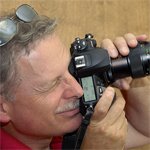Why Photographica?To pursue a practical but creative perspective in the wilds of digital photography, I enjoy learning and applying techniques needed for the new age of photography. Yet, I am also quick to dispel any untruths and seek enlightenment through an accurate view of new and emerging technologies. OK, enough on that...
A Little HistoryPhotography started for me in 1965 with a Kodak Tourist 620 rollfilm camera my Dad loaned me to shoot with at the Bronx Zoo on an eighth grade class trip. I can still remember shooting a Buddha-like Orangutan lazing in his cage. With a limited artistic ability to draw, seeing those color negatives turned into prints was my ticket to creativity.
I advanced into 35mm with Dad's Petri rangefinder, an Olympus PEN half-frame, and eventually financed my own SLR - an Exa 1A with a 50/2 Domiplan. Once I learned the basic film development and printing of monochrome films, I was off on the biggest discovery any 15-year-old could hope for - recording life!
Photojournalism was all around us in the sixties with Life and Look, National Geographic and the news magazines as major informants of the day. Inside their pages was an education for any budding visual artist like myself. Spurred on by the famous precursors of modern photojournalism, I never lacked for finding new subjects or shooting styles to develop in making memorable images.
As time went on I worked with most film format cameras at one point or another - Pentax Spotmatic, Mamiya C220 series, B&J 4X5 view, a Canon AT-1, Mamiya M645 system, N70/N80 Nikon film bodies and a slew of collectible 35mm and 120 folder cameras from th 1940's and 1950's. Eventually, I converted to digital starting with a D100 and traded up to a D70 a year later. Today I shoot with a D200 and, after November 2007, I will go on to the fabulous D300. A number of consumer Nikkor zooms became disappointing so I made it a priority to whittle the glass down to what shot best and reinvested in better gear overall (see The Mule Bag below).
Photography & Graphic DesignMy trade in life started in the litho industry - first running small presses, then larger ones, and eventually learning 4-color process prepress skills with litho film and masking sheets. this went on for 15 years when, in 1990, the computer made its debut in the graphic design world and printing slowly went digital. I jumped into the new technological waters with abandon - struggling to make sense of this new tool called a computer. After I had successfully transferred my chops from the analog printing world into the digital realm, I embarked on what I had dreamed of doing for years - graphic design. Today, I am a 'marketing design' resource that offers graphic design, photography, websites and turnkey production for engineering and business clients.
Photography has served me well all along the way. Never a full fledged "pro", I have shot my share of commercial imagery, weddings, microstock and art. It has augmented my marketing design services for litho reproduction with added value to customers looking for a one-stop marketing design resource.
My Camera BagI am in the process of upgrading from a D200 to a D300 - in the meantime i shoot with the Nikon D40 and the following optics: Nikon's 18-70G ED AF-S DX, 24-120G ED AF-S VR, 70-300 ED Nikkor, and Sigma 10-20 HSM DC.
Three AI primes include the celebrated 24/2.8 AI-S, 105/2.5 AI and 135/2.8 Q AI'd Nikkors of yesteryear - all will happily on the D300.
A well used Bogen 3221 tripod with a 3265 Griphead is always in the car. I have, but seldom use, a Bogen Monopod and QR Ballhead. A Markins M20 is in my future along with some lighter legs, but for now the Bogen gear has been a solid investment.
I also built a simple tabletop sweep out of PVC pipe and a flourescent lighting diffuser panel - works well for small items and is a mainstay for on-location small product shoots.
For flash, I utilize Nikon's CLS System with an SB800 Speedlight, five Sunpak (422D/433D) flash units combined with Wein shoe-mount and peanut optical slaves,, Bogen light stands, umbrella brackets, several umbrellas and the most used light modifier I keep in the bag - a pair of Gary Fong Lightspheres. These are invaluable for location shots where time and space does not permit a long setup and testing situation with traditional modifiers.
SoftwaresSince I started shooting with the D100 in 2002, I have paralleled my learning curve with digital darkroom skills as well. Alongside favorite graphic design softwares like Quark Xpress, FreeHand and Dreamweaver, my Athlon-powered PC and Macintosh G4 are stocked with applications for postprocessing with Photoshop CS, Lightroom, and Nikon Capture.
Shooting PreferencesWhat do I like to shoot? Everything! Favorites are architecture, products, people and nature, but any subject that has a picture potential is fair game for me. Portraiture is an area I would love to pursue but have little room for a studio to use lighting, etc. so must rely on chance opportunities as they appear.
So that's it. Not much more to tell about me - I'd rather concentrate on photography anyway! Hope you enjoy the commentary and images I present - feel free to make your comments.
Brian Patterson
www.brianrpatterson.com









